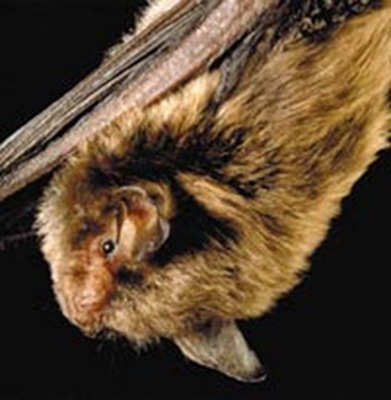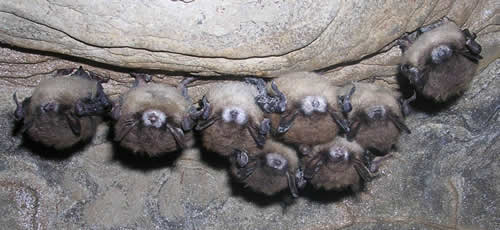
by Carolyn Gramling Thursday, January 5, 2012

The endangered Indiana bat. U.S. Fish and Wildlife Service

Bats with white-nose syndrome in New York. Nancy Heaslip, New York Dept. of Environmental Conservation
The name sounds pretty innocuous, but white-nose syndrome (WNS) is rapidly becoming very bad news for bats; in just a couple of years, hundreds of thousands of hibernating bats in the northeastern United States with this fungus have died. Among the most affected are the little brown bat and the endangered Indiana bat.
WNS is particularly bad in winter, because the fungus (thought to be of the genus Geomyces) likes cold temperatures, at which it colonizes animal skin. It produces a ring of white growth around the muzzles and on the wings of bats. However, it's not entirely clear how Geomyces causes death (or even if it's a direct cause rather than just an opportunistic infection affecting already weakened bats). One possibility is that the fungus disrupts the bats' hibernation and feeding cycles; awake and confused, they may leave the caves to hunt for food in winter, and starve; another is that declining insect populations due to pesticides may make the bats more susceptible to infection.
Whatever the cause, it's all happened so quickly: The fungus wasn't even identified until last October, and scientists still know little of how it's getting around so far so fast. First identified in New York in the winter of 2006-2007, WNS has since rapidly spread to at least 30 cave sites in four different states: New York, Pennsylvania, West Virginia and Virginia. But scientists increasingly suspect that humans are the vector — fungus spores may be hitching a ride on camera equipment and caving gear. (The U.S. Fish and Wildlife Service has guidelines for cleaning equipment.)
So for now, the Virginia Cave Board and the Natural Heritage Karst Program are asking for a voluntary moratorium on all underground caving in Virginia through April 15 while they try to identify which of the state's caves might be "significant" bat caves — the ones of particular importance to the bats' survival.
Still, once they've identified those caves, what to do in the longer run is still up in the air. Experts are all over the map regarding future protocols, not only for caving enthusiasts but also for researchers: Some say scientists should suspend their studies of the bats, since the scientists themselves might be part of the problem; others say that without those studies, how can we identify resistant species or sites? (On the most extreme end, some even suggest that selective "colony destruction" might be the only way to quarantine the disease.)
If you're an avid caver or just a fan of bats and would like to donate money for field and laboratory research to study the problem, the National Speleological Society has a fund set up here.
© 2008-2021. All rights reserved. Any copying, redistribution or retransmission of any of the contents of this service without the expressed written permission of the American Geosciences Institute is expressly prohibited. Click here for all copyright requests.